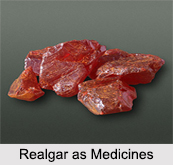 Realgar has long been used in traditional medicines for different diseases; so far it can be extremely toxic and carcinogenic. It has been studied as a drug for the treatment of cancer.
Realgar has long been used in traditional medicines for different diseases; so far it can be extremely toxic and carcinogenic. It has been studied as a drug for the treatment of cancer.
Benefits of Realgar
Realgar is purified by being rubbed with the juice of lemons or ginger. It is used internally in fever, skin diseases, cough, asthma, etc., and externally in skin diseases. In fever, it is generally used in combination with mercury, orpiment etc. The following is an illustration.
Dose of Realgar in Medicine
Chandesvara rasa: Take realgar, mercury, sulphur and aconite in equal parts, soak in the juice of Vitex Negundo (nirgundi) and of fresh ginger 3 times respectively, and make into 2 grain pills. This medicine is useful in remittent fever.
Svasa Kuthara Rasa: Take realgar, mercury, sulphur, aconite, borax each 1 part, black pepper 7 parts, ginger and long pepper 3 parts each, rub them together with water, and make into 4 grain pills. They are said to be useful in asthma with cough, and in remittent fever with cerebral complications. In coma from remittent fever, these pills are powdered and used as snuff for rousing the patient. They are also used in this manner in cephalalgia, hemicrania, ozaena, etc.
Realgar enters into the composition of numerous applications for skin diseases. Realgar mixed with the ashes of Achyranthes aspera (Apamarga) is applied to patches of leucoderma or white lepra. In leprous ulcers a liniment composed of realgar, orpiment black pepper, sesamum oil and the juice of Calotropis gigantea is used.
Chandraprabha Varti: Realgar enters into the composition of several applications for the eye, the following is an example. Take realgar, galena, conch-shell-lime, seeds of Moringa pterygosperma (Sveta Maricha), long pepper, liquorice and the kernel of Belleric myrobalan, equal parts, rub them together with goat"s milk, dry the mixture and make into small pastils or pencils. These are rubbed with a little honey and applied to the eves as a collyrium in afflictions of the internal tunics, tumors or other growths, night-blindness, etc.
An oil for application to fistulous sores is prepared as follows; take sulphur, realgar and turmeric, 8 tolas each, mustard oil 1 seer, juice of datura leaves 1 seer, water 4 seers; boil together in the usual way.




















